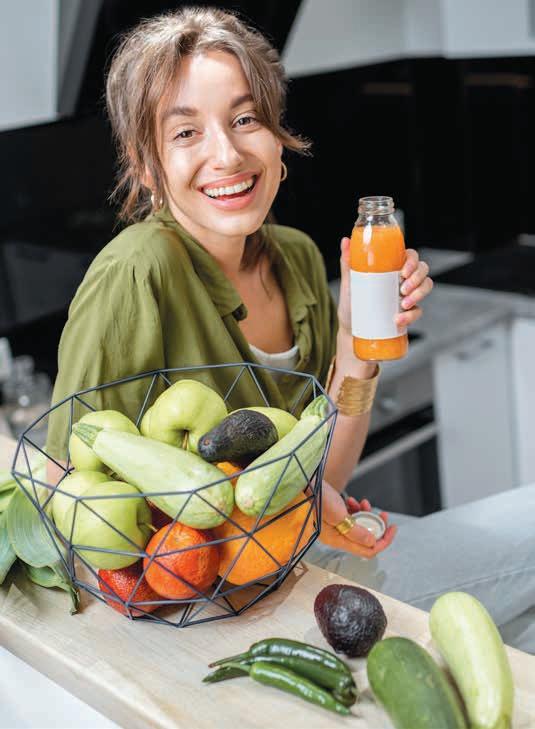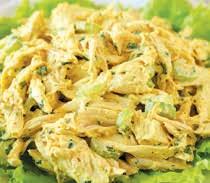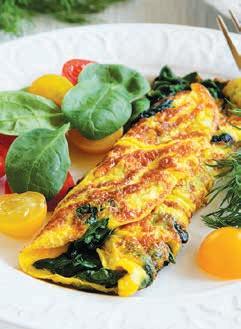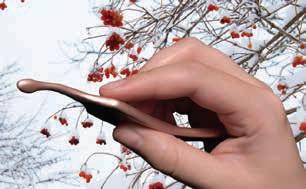
11 minute read
COOLING THE FIRE WITHIN
HEALTHY EATING TIPS TO EASE CHRONIC INFLAMMATION
by Tom O’Bryan
Advertisement
losangelai/Shutterstock.com P utting more thought into what we eat and why may be among the most important factors in determining how long we live. Researchers in Norway recently compared the long-term effects of a typical Western diet to an optimal one, and their findings can be a source for inspiration. The optimal diet had a substantially higher intake of whole grains, legumes, fish, fruits, vegetables and a handful of nuts, while reducing red and processed meats, sugar-sweetened beverages and refined grains.
According to their results, a sustained change from a typical Western diet to the better plan can make a big difference on life expectancy. Here are their predicted impacts on longevity for people after starting—and sticking to—an optimal diet: Start at age 20—women add 8.4 to 12.3 years; men add 9.4 to 14.3 years Start at age 60—women add 6.2 to 9.3 years; men add 6.8 to 10 years Start at age 80—women and men add 3.4 years So, it is never too late to start a positive activity.
This improved diet gets to the underlying causes of most of the reasons Americans die. According to the National Institutes of Health, 14 of the top 15 causes of death in 2019 were chronic inflammatory diseases. This means it is more than likely that the cause has existed for a long time under the surface (chronic), with too much inflammation for too long (inflammatory), affecting the brain, cardiovascular system, blood sugar system or wherever there is a genetic weak link (disease). Rather than
ask what the ailment is, ask, “Where is the long-term, hidden inflammation coming from that is fueling this disease?”
Dr. George Slavich, founding director of the Laboratory for Stress Assessment and Research at the University of California in Los Angeles, says that understanding when inflammation promotes either good or poor health and how and when to intervene to reduce inflammation-related disease risk, “should be a top scientific and public priority.” Identifying and reducing individual triggers of inflammation opens a path to regenerating a healthier, younger individual.
Not all inflammation is bad. Time-limited increases in inflammation are critical for promoting wound healing and recovery, as well as reducing the spread of communicable infections. Humans would not have lived very long without a well-developed internal protection from threatening environmental triggers such as bugs, parasites, viruses, mold, fungus and bacteria. For better health outcomes, we need to address excessive systemic inflammation. There are many likely contributors to the fueling of inflammation, but one of the most common sources is what is on the end of our fork. Begin there. LIFESTYLE HACK 1: If there is one prime directive for better health, it is to focus on living as much of an anti-inflammatory lifestyle as possible. Become more aware of the daily environmental exposures that ramp up inflammatory genes. Know, for example, what chemicals are used on the soil in which the food is grown or sprayed with before it is harvested. Then, armed with this knowledge, choose a better alternative, like organic and regenerative organic foods. As enough anti-inflammatory messages are accumulated, a reversal in the direction of health is possible. LIFESTYLE HACK 2: Food is the most common source of gasoline on the fire of inflammation. Dr. Deanna Minich, president of the American College of Nutrition, recommends the Rainbow Diet, which acts like a fire extinguisher to put out the excess inflammatory fire in the body. Selecting multiple colors of fruits and vegetables at every meal tempers the inflammatory cascade. Strive over time to eat 50 different fruits or vegetables per week. Begin today. Just bringing up to awareness the question, “Is this food inflammatory or anti-inflammatory?” will feed our health habits, and over time, healthier habits equal a healthier life.
KnoWEwell Chief Health Officer Dr. Tom O’Bryan, DC, CCN, DACBN, is an internationally recognized expert on gluten, bestselling author and speaker focused on food sensitivities, environmental toxins and the development of autoimmune diseases. He is a chiropractic doctor, certified clinical nutritionist and the founder of TheDr.com. YIELD: 4 SERVINGS

Zucchini can be fashioned into noodles one of two ways. For “fettuccine”, use a potato peeler to produce long, flat noodles or lengthwise ribbons. Peel off several from one side, then turn the zucchini and peel off more. Continue to turn and peel away ribbons, until reaching the seeds at the core of the zucchini, which can be discarded. For “spaghetti”, use a spiralizer, mandolin or knife. The spiralizer is the easiest option. With a mandolin, hook up the julienne attachment for perfectly formed noodles. If using a knife, cut the zucchini into thin slices, stack them up and cut again lengthwise into thin strips. Discard the core. Salt the zucchini noodles, let sit for a few minutes, then massage and squeeze the water out. Drain any excess liquid. Season the salmon with salt and pepper. In a large pan, heat the avocado oil over medium to high heat. Add the salmon, top sidedown, and sear until golden and crispy, then turn over to finish cooking. Cover only with a splatter screen, or it will not get crispy. In a wok or large pan over medium heat, add the olive oil and shallots, and cook until soft. Add the garlic and cook for 1 minute. Add the zucchini noodles, increase the heat to medium-high and cook for 2 minutes. Add the artichokes and lemon zest, stir to combine and cook for 1 minute. Turn off the heat and add the parsley, lemon juice and cayenne; stir to combine. Add the bacon and adjust seasonings to taste. Distribute evenly on 4 plates or low bowls. Place the salmon on top and serve with extra lemon.

6 zucchinis, medium to large, firm and straight, cut into “noodles” 2 lb fresh, wild salmon fillets, skin removed Sea salt and pepper 2 Tbsp high-heat cooking oil (avocado or grapeseed) 3 Tbsp olive oil 4 Tbsp shallots, minced 4 cloves garlic, minced 8 artichoke hearts (in water), quartered 1 lemon, zested and juiced 4 Tbsp fresh parsley, chopped Pinch of cayenne 6 slices crumbled, crispy turkey bacon; crispy bacon; or crispy pancetta
YIELD: 4 SERVINGS 4 organic, boneless, chicken breasts 1 to 2 bay leaves ½ cup chopped celery ½ cup chopped walnuts ⅔ cup avocado mayonnaise 2 tsp gluten-free Dijon mustard 1 tsp curry powder Sea salt and black pepper Wash and pat dry the chicken. Add water to a steamer (per manufacturer’s instructions) and add bay leaves. Place the chicken in the steamer basket and steam for 45 to 50 minutes. Do not overcook. Allow to cool, then shred or chop. In a large bowl, combine the chicken, celery, walnuts, mayonnaise, mustard, and curry. Blend well with a fork, taste and season with salt and pepper. Add the salad greens to plates and mound with the chicken salad. Garnish with parsley, avocado and pomegranate arils (seeds). If desired, drizzle salad greens with juice of a lemon and extravirgin olive oil. Recipe courtesy of Dr. Tom O’Bryan.
Liudmyla Chuhunova/Shutterstockcom

MOROCCAN CHICKPEA SOUP
YIELD: 4 SERVINGS
Th is fl avorful vegan soup is bursting with nutrition. Rich in fragrant anti-infl ammatory spices of cinnamon and turmeric and packed with protein thanks to the quick-cooking red lentils and chickpeas, it’s sure to satisfy. Add rice or rice vermicelli noodles and to make it an even heartier meal.
3 Tbsp Olive oil 1 onion, fi nely chopped 1 small celery rib (incl. leaves), fi nely chopped 1 large carrot, diced 1 tsp turmeric 1 tsp black pepper ½ tsp cinnamon 1 (28 oz.) can petite diced tomatoes 1 (16 oz.) can chickpeas, drained* 2/3 cup fresh cilantro, chopped 4 cups vegetable broth 1 cup red lentils 2 cups kale, thinly sliced ½ cup fresh fl at-leafed parsley, chopped Sea salt to taste Lemon wedges (optional)
Heat oil in a 4-quart Dutch oven or heavy saucepan. Cook chopped onion, celery and carrot over moderate heat until soft , stirring occasionally. Add turmeric, pepper and cinnamon and cook for three minutes.
Stir in tomatoes, chickpeas, cilantro, vegetable broth and lentils. Bring to a boil, then reduce heat and simmer, uncovered, until lentils are tender; about 35 minutes.
Stir in kale and cook an additional fi ve minutes, or until kale is wilted. Stir in parsley and salt to taste. Serve with lemon wedges and left over chopped cilantro or parsley, if desired. *Option: Use dried chickpeas to replace the canned. Soak 1 ½ cups dried chickpeas in water overnight. Drain, rinse and cook in about eight cups of water until tender, about 1 ½ hours. Recipe and photo courtesy of Gwen Eberly, a Lancaster, PA-based Montessori art teacher and chef who teaches cooking to kids and teens at Zest! Cooking School in Lititz, PA. Connect on Instagram or at EberlyG@comcast.net.
ARTICHOKE AND SPINACH GREEK OMELET

YIELD: 4 SERVINGS
10 eggs 1 cup chopped artichoke hearts, packed in water 1 large tomato 4 oz fresh baby spinach, chopped 2 cloves garlic, minced ⅔ cup green olives, chopped ½ tsp dried thyme ½ tsp dried oregano Sea salt and freshly ground black pepper 2 Tbsp coconut oil
In a large bowl, whisk together all the ingredients except the oil. Heat the oil in a large skillet over medium high heat. Pour the mixture into the skillet. After 1 to 2 minutes, when the omelet has begun to brown, fold it in half and continue to cook for another 1 to 2 minutes on each side until the center is cooked through. Serve immediately.
Recipe courtesy of Dr. Tom O’Bryan.
Natural Virus Killer
Copper can stop a virus before it starts
By Doug Cornell
Scientists have discovered a natural way to kill germs fast.
Now thousands of people are using it against viruses and bacteria that cause illness.
Colds and many other illnesses start when viruses get in your nose and multiply. If you don’t stop them early, they spread and cause misery.
Hundreds of studies confirm copper kills viruses and bacteria almost instantly just by touch.
That’s why ancient Greeks and Egyptians used copper to purify water and heal wounds. They didn’t know about viruses and bacteria, but now we do.
“The antimicrobial activity of copper is well established.” National Institutes of Health.
Scientists say copper’s high conductance disrupts the electrical balance in a microbe cell and destroys it in seconds.
The EPA recommended hospitals use copper for touch surfaces like faucets and doorknobs. This cut the spread of MRSA and other illnesses by over half, and saved lives.
The strong scientific evidence gave inventor Doug Cornell an idea. He made a smooth copper probe
with a tip to fit in the bottom of the nostril, where viruses collect. When he felt a tickle in his nose like a cold about to start, he rubbed the copper gently in his nose for 60 seconds. “It worked!” he exclaimed. “The cold never happened. I used to get 2-3 bad colds every New research: Copper kills viruses in seconds. year. Now I use my device whenever I feel a sign I am about to get sick.” He hasn’t had a cold in 10 years. Users say:
“It works! I love it!” “I can’t believe how good my nose feels.” “Is it supposed to work that fast?” “One of the best presents ever.” “Sixteen flights, not a sniffle!” “Cold sores gone!” “It saved me last holidays. The kids all got sick, but not me.” “I am shocked! My sinus cleared, no more headache, no more congestion.” “Best sleep I’ve had in years!”
After his first success with it, he asked relatives and friends to try it. They all said it worked, so he patented CopperZap® and put it on the market.
Soon hundreds of people had tried it. 99% said copper worked if they used it right away at the first sign of germs, like a tickle in the nose or a scratchy throat.
Longtime users say they haven’t been sick in years. They have less stress, less medical costs, and more time to enjoy life.
Soon people found other things they could use it against.

Colds Flu Virus variants Sinus trouble Cold sores Fever blisters Canker sores Strep throat Night stuffiness Morning congestion Nasal drip Infected sores Infected wounds Styes Warts Ringworm Other microbial threats
The handle is curved and textured to increase contact. Copper can kill germs picked up on fingers and hands after you touch things other people have touched.
The EPA says copper works just as well when tarnished.
Dr. Bill Keevil led one of the science teams. He placed millions of viruses on a copper surface. “They started to die literally as soon as they touched it.”
CopperZap® is made in the USA of pure copper. It has a 90-day full money back guarantee. Price $79.95. Get $10 off each CopperZap with code NATA34.
Go to www.CopperZap.com or call toll-free 1-888-411-6114. Buy once, use forever.
Statements are not intended as product health claims and have not been evaluated by the FDA. Not claimed to diagnose, treat, cure, or prevent any disease.








